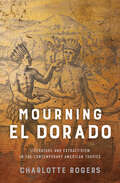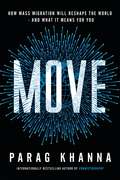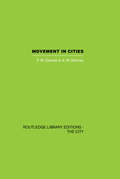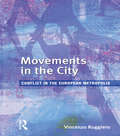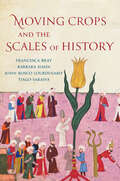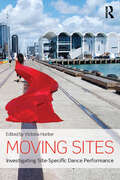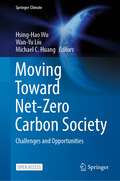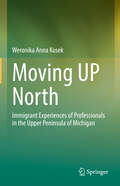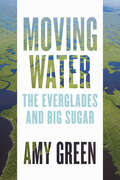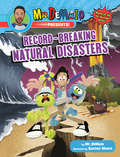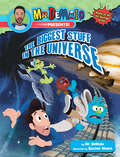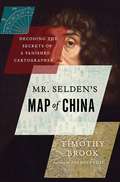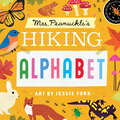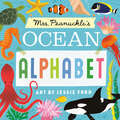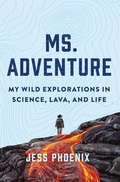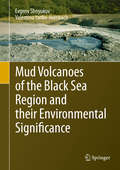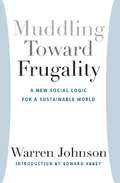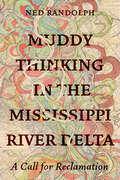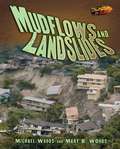- Table View
- List View
Mourning El Dorado: Literature and Extractivism in the Contemporary American Tropics (New World Studies)
by Charlotte RogersWhat ever happened to the legend of El Dorado, the tale of the mythical city of gold lost in the Amazon jungle? Charlotte Rogers argues that El Dorado has not been forgotten and still inspires the reckless pursuit of illusory wealth. The search for gold in South America during the colonial period inaugurated the "promise of El Dorado"—the belief that wealth and happiness can be found in the tropical forests of the Americas. That assumption has endured over the course of centuries, still evident in the various modes of natural resource extraction, such as oil drilling and mining, that characterize the region today.Mourning El Dorado looks at how fiction from the American tropics written since 1950 engages with the promise of El Dorado in the age of the Anthropocene. Just as the golden kingdom was never found, natural resource extraction has not produced wealth and happiness for the peoples of the tropics. While extractivism enriches a few outsiders, it results in environmental degradation and the subjugation, displacement, and forced assimilation of native peoples. This book considers how the fiction of five writers—Alejo Carpentier, Wilson Harris, Mario Vargas Llosa, Álvaro Mutis, and Milton Hatoum—criticizes extractive practices and mourns the lost illusion of the forest as a place of wealth and happiness.
Move: How Mass Migration Will Reshape the World – and What It Means for You
by Parag KhannaWhere will you live in 2030? Where will your children settle in 2040? What will the map of humanity look like in 2050?In the 60,000 years since people began colonising the continents, a recurring feature of human civilisation has been mobility - the constant search for resources and stability. Seismic global events - wars and genocides, revolutions and pandemics - have only accelerated the process. The map of humanity isn't settled, not now, not ever.As climate change tips toward full-blown crisis, economies collapse, governments destabilise and technology disrupts, we're entering a new age of mass migrations - one that will scatter both the dispossessed and the well-off. Which areas will people abandon and where will they resettle? Which countries will accept or reject them? As today's world population, which includes four billion restless youth, votes with their feet, what map of human geography will emerge?Here global strategy advisor Parag Khanna provides an illuminating and authoritative vision of the next phase of human civilisation - one that is both mobile and sustainable. As the book explores, in the years ahead people will move to where the resources are and technologies will flow to the people who need them, returning us to our nomadic roots while building more secure habitats. Move is a fascinating look at the deep trends that are shaping the most likely scenarios for the future. Most importantly, it guides each of us as we determine our optimal location on humanity's ever-changing map.
Movement in Cities: Spatial Perspectives On Urban Transport And Travel
by P.W. Daniels A.M. WarnesMovement in Cities describes and analyses urban travel in terms of purpose, distance and frequency of journeys and modes and routes used, concentrating mainly on British towns with many references to the United States and Australia. The authors elucidate the all-important interrelations between location of activities and the patterns of transport supply and use within towns. The issues they raise are of pressing practical and intellectual importance. This book was first published in 1980.
Movements in the City: Conflict in the European Metropolis
by Vincenzo RuggieroFor 2nd and 3rd year courses in urban sociology, sociology of exclusion, social stratification, planning and cultural studies in departments of sociology and urban geography. This book provides an in depth examination of social movements and urban life in European cities today. Unique in its interdisciplinary approach, it covers traditional areas of urban studies, sociological concerns about the concept of change and the characteristics of social movements. It presents current theory as well as discursive sections based around empirical work conducted in major European cities including London, Paris and Berlin.
Moving Crops and the Scales of History (Yale Agrarian Studies Series)
by Francesca Bray Barbara Hahn John Bosco LourdusamyA bold redefinition of historical inquiry based on the “cropscape”—the people, creatures, technologies, ideas, and places that surround a crop Human efforts to move crops from one place to another have been a key driving force in history. Crops have been on the move for millennia, from wildlands into fields, from wetlands to dry zones, from one imperial colony to another. This book is a bold but approachable attempt to redefine historical inquiry based on the “cropscape”: the assemblage of people, places, creatures, technologies, and other elements that form around a crop. The cropscape is a method of reconnecting the global with the local, the longue durée with microhistory, and people, plants, and places with abstract concepts such as tastes, ideas, skills, politics, and economic forces. Through investigating a range of contrasting cropscapes spanning millennia and the globe, the authors break open traditional historical structures of period, geography, and direction to glean insight into previously invisible actors and forces.
Moving Sites: Investigating Site-Specific Dance Performance
by Victoria HunterMoving Sites explores site-specific dance practice through a combination of analytical essays and practitioner accounts of their working processes. In offering this joint effort of theory and practice, it aims to provide dance academics, students and practitioners with a series of discussions that shed light both on approaches to making this type of dance practice, and evaluating and reflecting on it. The edited volume combines critical thinking from a range of perspectives including commentary and observation from the fields of dance studies, human geography and spatial theory in order to present interdisciplinary discourse and a range of critical and practice-led lenses through which this type of work can be considered and explored. In so doing, this book addresses the following questions: · How do choreographers make site-specific dance performance? · What occurs when a moving body engages with site, place and environment? · How might we interpret, analyse and evaluate this type of dance practice through a range of theoretical lenses? · How can this type of practice inform wider discussions of embodiment, site, space, place and environment? This innovative and exciting book seeks to move beyond description and discussion of site-specific dance as a spectacle or novelty and considers site-dance as a valid and vital form of contemporary dance practice that explores, reflects, disrupts, contests and develops understandings and practices of inhabiting and engaging with a range of sites and environments. Dr Victoria Hunter is Senior Lecturer in Dance at the University of Chichester.
Moving Toward Net-Zero Carbon Society: Challenges and Opportunities (Springer Climate)
by Hsing-Hao Wu Wan-Yu Liu Michael C. HuangThis open access book explores various issues concerning the net-zero emission achievement, ranging from carbon pricing, carbon trade schemes, energy transition, ecological conservation, and carbon sinks, as well as the economic and social impacts of introducing carbon neutral policies in the Asia-Pacific region. The extreme flooding and drought problems, crop yield problems, and habitat changes brought about by climate change have seriously threatened the ecosystem and human survival, forcing people to rethink environmental management policies and limits on economic development. In the post-COVID-10 era, it is indispensable to adopt a more proactive climate change adaptation policy and establish bilateral cooperation with international partners who value climate change. 2021 is a critical year, and the leaders of major industrial countries at the recently concluded G7 meeting jointly stated the common objective seeking the establishment of carbon-neutral international community by the mid of the century. Major carbon-emitting countries or entities such as the European Union, US, Japan, Korea, China, and India have proposed specific timetables for net-zero carbon emissions and carbon neutrality before or at the COP26. Policy-makers around the world would also work closely with scientists, experts, and enterprises seeking appropriate policy instruments such as the development of carbon tax, carbon pricing, carbon sinks, global or regional carbon emission trade schemes, energy transitions, and other carbon-neutral policies moving toward net-zero emission society by the mid of the century. At a time when carbon pricing policies are being formulated, climate change related laws and policies will reshape the global governance and industrial layout during the period of 2021–-2030, and it is critical to move toward energy and industrial transformation, ecological conservation, and sustainable agricultural development.
Moving UP North: Immigrant Experiences of Professionals in the Upper Peninsula of Michigan
by Weronika Anna KusekThis monograph presents the migratory journey and personal experiences of immigrant professionals who live and work in the Upper Peninsula of Michigan – a remote region of the United States which heavily relies on a group of professional immigrants to provide various services to the local community. Professors, physicians, engineers, remote workers but also foreign spouses of local residents tell their stories and provide a unique perspective on assimilation, cultural adjustment, and making home away from home. Transnational migrants transcend national boundaries in search of better educational, professional, and/ or personal opportunities and experiences. In the United States, most current research focuses on chain migration and more specifically laborers and/or undocumented immigrants mainly in urban area contexts. There has also been vast literature that focuses on socio-economic polarization in the context of global elites who influence urban areas. But little attention has been given to professional immigrants who settle in small towns and rural areas of the United States especially in the North. The book is composed of 12 chapters: in addition to introductory and summary chapters, ten chapters are focused on individual experiences of international professionals. The chapters tell a story of transnational immigrants who live and work in the Upper Peninsula of Michigan. Each chapter is based on an interview with an international professional who lives in the region: some of the immigrants have been in the area for a couple of decades and others are newcomers.
Moving Water: The Everglades and Big Sugar
by Amy GreenA riveting story of environmental disaster and political intrigue, Moving Water exposes how Florida's clean water is threatened by dirty power players and the sugar cane industry.Only a century ago, nearly all of South Florida was under water. The Everglades, one of the largest wetlands in the world, was a watery arc extending over 3 million acres. Today, that wetland ecosystem is half of its former self, supplanted by housing for the region's exploding population and over 700,000 acres of crops, including the nation's largest supply of sugar cane. Countless canals, dams, and pump stations keep the trickle flowing, but rarely address the cascade of environmental consequences, including dangerous threats to a crucial drinking water source for a full third of Florida's residents. In Moving Water, environmental journalist Amy Green explores the story of unlikely conservation heroes George and Mary Barley, wealthy real estate developers and champions of the Everglades, whose complicated legacy spans from fisheries in Florida Bay to the political worlds of Tallahassee and Washington. At the center of their surprising saga is the establishment and evolution of the Comprehensive Everglades Restoration Plan (CERP), a $17 billion taxpayer-funded initiative aimed at reclaiming this vital ecosystem. Green explains that, like the meandering River of Grass, the progress of CERP rarely runs straight, especially when it comes up against the fierce efforts of sugar-growing interests, or "Big Sugar," to obstruct the cleanup of fertilizer runoff wreaking havoc with restoration. This engrossing exposé tackles some of the most important issues of our time: Is it possible to save a complex ecosystem such as the Everglades—or, once degraded, are such ecological wonders gone forever? What kind of commitments—economic, scientific, and social—will it take to rescue our vulnerable natural resources? What influences do special interests wield in our everyday lives, and what does it take to push real reform through our democracy? A must-read for anyone fascinated by stories of political intrigue and the work of environmental crusaders like Erin Brockovich, as well as anyone who cares about the future of Florida, this book reveals why the Everglades serve as a model—and a warning—for environmental restoration efforts worldwide.
Mr. DeMaio Presents!: Based on the Hit YouTube Series!
by Mike DeMaioMr. DeMaio Presents! = STEM + (Jokes x Fun) --Publishers WeeklyFollow along with Mr. DeMaio and his comical crew as they explore the world and beyond in search of the most destructive disasters to date!Hurricanes, tornadoes, tsunamis ... oh my! In the first installment of the Mr. DeMaio Presents! series, YouTube sensation Mr. DeMaio and his crew unearth all the facts for record-breaking natural disasters that have occured on planet Earth ... and even a few in outer space! With full color photographs and illustrations, this book from popular YouTuber (over 290k subscribers) and science teacher Mr. DeMaio will keep kids entertained while educating!
Mr. DeMaio Presents!: Based on the Hit YouTube Series!
by Mike DeMaioMr. DeMaio Presents! = STEM + (Jokes x Fun) --Publishers WeeklyFollow along with Mr. DeMaio and his comical crew as they explore the world and beyond in search of the biggest stuff in the universe!Mega space volcanoes...super-giant asteroids...a twenty-six-pound gummy bear? In the second installment of the Mr. DeMaio Presents! series, the crew is traveling across the galaxy in search of the biggest stuff in the universe...even if that means a sugary piece of candy that weighs more than three bowling balls! With full color photographs and illustrations, this book from popular YouTuber (over 290k subscribers) and science teacher Mr. DeMaio will keep kids entertained while educating!
Mr. Hornaday's War: How a Peculiar Victorian Zookeeper Waged a Lonely Crusade for Wildlife That Changed the World
by Stefan BechtelHe was complex, quirky, pugnacious, and difficult. He seemed to create enemies wherever he went, even among his friends. A fireplug of a man who stood only five feet eight inches in his stocking feet, he had an outsized ambition to make his mark on the world. And he did. William Temple Hornaday (1854-1937) was probably the most famous conservationist of the nineteenth century, second only to his great friend and ally Theodore Roosevelt. Hornaday's great passion was protecting wild things and wild places, and he spent most of his adult life in a state of war on their behalf, as a taxidermist and museum collector; as the founder and first director of the National Zoo in Washington, DC; as director of the Bronx Zoo for thirty years; and as the author of nearly two dozen books on conservation and wildlife. But in Mr. Hornaday's War, the long-overdue biography of Hornaday by journalist Stefan Bechtel, the grinding contradictions of Hornaday's life also become clear. Though he is credited with saving the American bison from extinction, he began his career as a rifleman and trophy hunter who led "the last buffalo hunt" into the Montana Territory. And what happened in 1906 at the Bronx Zoo, when Hornaday displayed an African man in a cage, shows a side of him that is as baffling as it is repellent. This gripping new book takes an honest look at a fascinating and enigmatic man.
Mr. Selden's Map of China: Decoding the Secrets of a Vanished Cartographer
by Timothy BrookSelected for The Globe 100 Books in 2013. A fascinating work of history, biography, cartography, and literary mystery, Mr Selden’s Map of China unlocks the secrets behind a recently discovered map of China like no other of its time. In 1659, a vast and unusual map of China arrived in the Bodleian Library, Oxford. It was bequeathed by John Selden, a London business lawyer, political activist, former convict, MP, and the city’s first Orientalist scholar. Largely ignored, it remained in the bowels of the library, until called up by an inquisitive reader. When Timothy Brook saw it in 2009, he realized that the Selden Map was “a puzzle that had to be solved”: an exceptional artefact so unsettlingly modern-looking it could almost be a forgery. But it was genuine, and what it has to tell us is astonishing. It shows China, not cut off from the world, but a participant in the embryonic networks of global trade that fuelled the rise of Europe — and now power China’s ascent. And it raises as many question as it answers: How did John Selden acquire it? Where did it come from? Who re-imagined the world in this way and, most importantly, what can it tell us about the world at that time? Like a cartographic detective, award-winning author and historian Timothy Brook has provided answers. From the Gobi Desert to the Philippines, from Java to Tibet, and into China itself, Brook uses the map to tease out the varied elements that defined this crucial period in China’s history.
Mr. Wilson's Cabinet of Wonder: Pronged Ants, Horned Humans, Mice on Toast, and Other Marvels of Jurassic Technology
by Lawrence WeschlerWriting with great style and humor, Weschler guides the readers through the Museum of Jurassic Technology and through the mind of its curator, David Wilson, a man of unusual imagination who mounts exhibits such as spore-inhaling ants, bats deploying ultraviolet frequencies, peach-pit carvings, and other exhibits that seem the manifest definition of bizarre.
Mrs. Peanuckle's Earth Alphabet (Mrs. Peanuckle's Alphabet #9)
by Mrs. PeanuckleExplore our wondrous planet while learning the ABCs with Mrs. Peanuckle! With playful text, bright illustrations, and sturdy pages, this alphabet book will engage toddlers, and take them on an alphabet adventure through the natural world!Mrs. Peanuckle shares everything that makes Earth so special—and all the important ways we can protect our home from climate change in her latest tour of the ABCs! From A to Z, Mrs. Peanuckle introduces toddlers to 26 different natural-world experiences. With bold, colorful pages, strong graphic art, and exciting design, these simple nature words are sure to be a hit with budding environmentalists and curious young scientists.Collect all of Mrs. Peanuckle's Alphabet books, including: KitchenHikingBirdTreeBugFlowerFruitVegetable
Mrs. Peanuckle's Hiking Alphabet
by Mrs. PeanuckleWith playful text, bright illustrations, and sturdy pages, Mrs. Peanuckle's alphabet books will engage toddlers, and take them on an alphabet adventure through the natural world!Explore the wondrous world of hiking while learning the ABCs with Mrs. Peanuckle! Mrs. Peanuckle takes on the outdoors and shares all her favorite animals, plants, and more in her latest tour of the ABCs! From A to Z, Mrs. Peanuckle introduces toddlers to 26 different natural-world experiences. With bold, colorful pages, strong graphic art, and exciting design, these simple nature words are sure to be a hit with budding hikers and curious young scientists. Collect all of Mrs. Peanuckle's Alphabets, including: Kitchen, Hiking, Bird, Tree, Bug, Flower, Fruit, and Vegetable!
Mrs. Peanuckle's Ocean Alphabet (Mrs. Peanuckle's Alphabet #10)
by Mrs. PeanuckleMrs. Peanuckle's alphabet books engage toddlers with interesting and informative words, graphic art, and sturdy pages!From A to Z, Mrs. Peanuckle introduces toddlers to words about the earth's oceans. These simple nature words are sure to be a hit with budding biologists, curious young environmentalists, and parents and teachers who want to encourage learning and an awareness of our unique planet! Collect all of Mrs. Peanuckle's Alphabet books, including Fruit, Vegetable, Bug, Flower, Bird, Tree, Hiking, Kitchen, and Earth!
Mrs. Perkins's Electric Quilt: And Other Intriguing Stories of Mathematical Physics
by Paul J. NahinAn incomparable collection of stimulating math puzzles from bestselling author Paul NahinWhat does quilting have to do with electric circuit theory? The answer is just one of the fascinating ways that best-selling popular math writer Paul Nahin illustrates the deep interplay of math and physics in the world around us in his latest book of challenging mathematical puzzles, Mrs. Perkins's Electric Quilt. With his trademark combination of intriguing mathematical problems and the historical anecdotes surrounding them, Nahin invites readers on an exciting and informative exploration of some of the many ways math and physics combine to create something vastly more powerful, useful, and interesting than either is by itself.In a series of brief and largely self-contained chapters, Nahin discusses a wide range of topics in which math and physics are mutually dependent and mutually illuminating, from Newtonian gravity and Newton's laws of mechanics to ballistics, air drag, and electricity. The mathematical subjects range from algebra, trigonometry, geometry, and calculus to differential equations, Fourier series, and theoretical and Monte Carlo probability. Each chapter includes problems—some three dozen in all—that challenge readers to try their hand at applying what they have learned. Just as in his other books of mathematical puzzles, Nahin discusses the historical background of each problem, gives many examples, includes MATLAB codes, and provides complete and detailed solutions at the end.Mrs. Perkins's Electric Quilt will appeal to students interested in new math and physics applications, teachers looking for unusual examples to use in class—and anyone who enjoys popular math books.
Ms. Adventure: My Wild Explorations in Science, Lava, and Life
by Jess Phoenix"Jess Phoenix's work encompasses science and representation in such a delightful melding that it could only come from as spry and playful a soul as hers! Open this book and jump into the volcano!" —Patton Oswalt As a volcanologist, natural hazards expert, and founder of Blueprint Earth, Jess Phoenix has dedicated her life to scientific exploration. Her career path—hard earned in the male-dominated world of science—has led her into still-flowing Hawaiian lava fields, congressional races, glittering cocktail parties at Manhattan&’s elite Explorers Club, and numerous pairs of Caterpillar work boots. It has also inspired her to devote her life to making science more inclusive and accessible. Ms. Adventure skillfully blends personal memoir, daring adventure, and scientific exploration, following Phoenix&’s journey from reality television sites deep in Ecuadorian jungles to Andean glaciers, university classrooms to Death Valley in summer. She has even chased down members of a Mexican cartel to retrieve a stolen favorite rock hammer. Readers will delight in her unbelievable adventures, all embarked on for the love of science.
Mud Volcanoes of the Black Sea Region and their Environmental Significance
by Evgeny Shnyukov Valentina Yanko-HombachThis exceptionally well-illustrated book at a high scientific level describes mud volcanism as a complex, multidimensional phenomenon requiring multidisciplinary study. Mud volcanoes can be used as “cheap windows” to search for gas-hydrates and other mineral resources in the Black Sea region. Nothing similar has been published before, and as one of its unique features the book includes a vast amount of new data unavailable so far to the western reader. The book includes new data on driving forces, mechanisms, origin, geological and geomorphological features of mud volcanoes as well as new data on composition of solid, gaseous, and liquid components of erupted material. It covers a wide geographic region, and its subjects range from geological to environmental to industrial applications.
Muddling Toward Frugality
by Warren JohnsonMr. Johnson's thesis can be summarized without much difficulty: after generations of extravagant and reckless industrial expansion, we are clearly entering an age of economic scarcity. While human demands continue to rise, natural resources, especially the non-renewable kind, become harder to find and more expensive to extract, process, transport and distribute. This simple brute fact is the basic cause of inflation, despite the inability of most professional economists to see it. (The "dismal science" has never been more dismally obtuse than it is today.) The law of diminishing returns is coming into effect. Technological developments can delay the process but not halt or reverse it; nor can we rely on government or big business to save us. Planning for further growth delays the adjustments that must be made, makes a fair sharing of necessary sacrifices more troublesome, and if carried too far will make more severe and painful, because rapid, the inevitable decline of the international economic machine. The best way to deal with the end of affluence is to accept it-not fight it-and to begin, here and now, the unavoidable adaptations, on an individual, family, and community basis. Piecemeal, experimental, and muddling.
Muddy Thinking in the Mississippi River Delta: A Call for Reclamation
by Ned RandolphA free ebook version of this title is available through Luminos, University of California Press's Open Access publishing program. Visit www.luminosoa.org to learn more.Muddy Thinking in the Mississippi River Delta uses the story of mud to answer a deceptively simple question: How can a place uniquely vulnerable to sea level rise be one of the nation's most promiscuous producers and consumers of fossil fuels? Organized around New Orleans and South Louisiana as a case study, this book examines how the unruly Mississippi River and its muddy delta shaped the people, culture, and governance of the region. It proposes a framework of "muddy thinking" to gum the wheels of extractive capitalism and pollution that have brought us to the precipice of planetary collapse. Muddy Thinking calls upon our dirty, shared histories to address urgent questions of mutual survival and care in a rapidly changing world.
Mudflows and Landslides
by Michael Woods Mary B. WoodsImagine that you hear a faint rumbling sound coming from a hillside. the noise gets louder, and when you turn to look, a river of mud is flowing toward you! Big mudflows and landslides can happen unexpectedly, causing terrible disasters. the moving mass of soil and rock carries away people, animals, houses, cars, bridges, trees, and anything else in its path. with dramatic images and firsthand survivor stories--plus the latest facts and figures--this book shows you some of the world's biggest mudflow and landslide disasters up close.
Multi-Component Acoustic Characterization of Porous Media
by Karel N. van DalenThe feasibility to extract porous medium parameters from acoustic recordings is investigated. The thesis gives an excellent discussion of our basic understanding of different wave modes, using a full-waveform and multi-component approach. Focus lies on the dependency on porosity and permeability where especially the latter is difficult to estimate. In this thesis, this sensitivity is shown for interface-wave and reflected-wave modes. For each of the pseudo-Rayleigh and pseudo-Stoneley interface waves unique estimates for permeability and porosity can be obtained when impedance and attenuation are combined. The pseudo-Stoneley wave is most sensitive to permeability: both the impedance and the attenuation are controlled by the fluid flow. Also from reflected-wave modes unique estimates for permeability and porosity can be obtained when the reflection coefficients of different reflected modes are combined. In this case the sensitivity to permeability is caused by subsurface heterogeneities generating mesoscopic fluid flow at seismic frequencies. The results of this thesis suggest that estimation of in-situ permeability is feasible, provided detection is carried out with multi-component measurements. The results of this thesis argely affect geotechnical and reservoir engineering practices.
Multi-Cultural Artisanal Entrepreneurship: Challenges, Opportunities, and Future Trends (Routledge Advances in Management and Business Studies)
by Pawan Kumar Kulvinder Kaur Rajesh VermaIn recent years, the realm of entrepreneurship has witnessed the emergence of a distinctive domain: multi-cultural artisanal entrepreneurship. This research book dives into this novel area, unravelling the challenges, exploring the opportunities, and identifying future trends within this dynamic field. The main themes include cultural diversity, language barriers, global resource accessibility, market expansion, leveraging cultural differences, sustainability, technological impact, and cross-cultural collaboration. With an emphasis on the challenges faced by multi-cultural artisanal entrepreneurs, including issues related to cultural dynamics, language barriers, and access to resources across the globe, this research volume investigates the opportunities available to artisanal entrepreneurs. These include access to new markets, increased demand for unique products, as well as the ability to leverage cultural dynamics for competitive advantage. Finally, the book examines future trends in multi-cultural artisanal entrepreneurship, including the impact of emerging technologies and leveraging the potential of cross-cultural collaboration.Readers, particularly researchers, academics, and students in the field of entrepreneurship, will gain a nuanced understanding of multi-cultural artisanal entrepreneurship, positioning them to navigate the complexities of this field and contribute to its sustainable growth. The findings of this research will also be beneficial for academicians, small business owners, policy makers and organisations at large.
